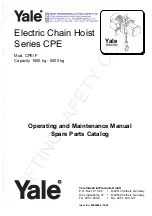
9
ENG
L
ISH
9.
LABELS AND TAGS. Check for presence and legibility. Replace if necessary.
10.
LOAD CHAIN END ANCHORS. Ensure both ends of load chain are securely attached. Secure if loose, repair if
damaged, replace if missing.
11.
LOAD CHAIN. Measure the chain for stretching
by measuring across five link sections all along the
chain (refer to Dwg. MHP0041) paying particular
attention to the most reeved links. When any five
links in the working length reach or exceed the
discard length shown in Table 3, replace the entire
chain. Always use genuine
Ingersoll Rand
replacement chain.
(Dwg. MHP0041)
12.
CHAIN CONTAINER. Check for damage or
excessive wear and that chain container is securely
attached to the hoist. Secure or replace if necessary.
13.
LIMIT ASSEMBLY. Check limit switch moves
freely. To limit hook downward travel the loop in
the slack chain side must contact the limit switch.
To limit hook upward travel the bottom hook block
must contact the limit switch.
To test “UP” and “DOWN” travel limits first run
hoist slowly with no load to verify proper function.
Repeat test at full speed with no load to verify
proper function.
Zinc plated load chain is standard on Palair and Liftchain
hoists.
Hoists Not in Regular Use
1.
A hoist which has been idle for a period of one month or more, but less than one year, should be given an inspection
conforming with the requirements of “Frequent Inspection” before being placed into service.
2.
A hoist which has been idle for a period of more than one year should be given a complete inspection conforming
with the requirements of “Periodic Inspection” before being placed into service.
3.
Standby hoists should be inspected at least semiannually in accordance with the requirements of “Frequent
Inspection”. In abnormal operating conditions equipment should be inspected at shorter intervals.
LUBRICATION
To ensure continued satisfactory operation of the hoist, all points requiring lubrication must be serviced with the correct
lubricant at the proper time interval as indicated for each assembly. Correct lubrication is one of the most important
factors in maintaining efficient operation.
The lubrication intervals recommended in this manual are based on intermittent operation of the hoist eight hours each
day, five days per week. If the hoist is operated almost continuously or more than the eight hours each day, more frequent
lubrication will be required. Also, the lubricant types and change intervals are based on operation in an environment
relatively free of dust, moisture, and corrosive fumes. Use only those lubricants recommended. Other lubricants may
affect the performance of the hoist. Failure to observe this precaution may result in damage to the hoist and/or its
associated components.
Air Line Lubricator
(if used)
Lubricate the hoist supply air with SAE 30W ISO VG100 non-detergent motor oil (minimum viscosity 135 Cst at 40° C)
from an in-line lubricator. The use of detergent oil may cause premature failure.
Load Chain
WARNING
• Failure to maintain clean and well lubricated load chain will result in rapid load chain wear that can lead to
chain failure which can cause severe injury, death or substantial property damage.
Table 3
Model No.
Chain
Size
mm
Normal
Length
mm
Discard
Length
mm
Palair 250 to 1000 kg
5 x 15
75
76.1
Palair 1001 to 2000 kg
7 x 21
105
106.5
LCA015S-E and
LCA030D-E
8 x 24
120
122
LCA030S-E and
LCA060D-E
13 x 36
180
183
LCA060S-E,
LCA120D-E,
LCA180T-E and
LCA250Q-E
16 x 45
225
228
LCA125S-E,
LCA250D-E,
LCA375T-E,
LCA500Q-E,
LCA750T-E,
LCA1000Q-E
22 x 66
330
335































